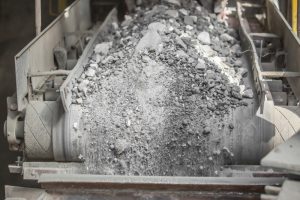
Cement is an important building material with the global demand expected to reach 4.73 billion tons by 2025. However, many cement plants struggle to keep up with production because of bulk solid flow problems. Materials like limestone, slag, bauxite, gypsum, and clay are prone to bridging, ratholing, and flooding. Moisture—especially in Asia and other humid environments—can also harden materials during storage.
Plant operators often resort to makeshift solutions like hammering the vessel. However, this seemingly “cheap fix” is slow and has hidden costs: slow productivity, safety risks, and damage to the vessels. Flow aids can help clear out material blocks and improve production, but it is necessary to find one that is effective for cement materials.
4 Factors When Selecting a Flow Aid for the Cement Industry
- Material activation. The flow aid must be able to handle heavy materials and large volumes. Some flow aids like fluidizers, which use a combination of gentle air pulses and vibration, are only effective for light powders that respond to light aeration.
- Energy consumption. Air cannons and air knockers have more power than fluidizers, but also require a lot of energy and plant air. Vibrators can also be expensive to operate because they run continuously. This is a big factor for countries that have high electricity prices, particularly in Asia and Europe.
- Reliability. Ideally, flow aids provide on-demand, first-in / first-out flow. Stagnant material left in the vessel can compromise product consistency and safety. For example, some additives like magnesium oxide can add strength but must be used in precise quantities so the product remains stable.
- Maintenance time and cost. Part of productivity includes shortening maintenance and cleaning times. Flow aids that are installed outside of the vessel, and can easily be removed even when they are located higher up in the silo or hopper, can significantly simplify routine maintenance.
AirSweep is One of the Most Trusted Flow Aids in the Cement Industry
AirSweep is a pneumatic flow aid that releases high-pressure, high-volume, 360-degree bursts of compressed air, which lifts stalled material back into the flow stream. It is used by cement companies around the world, such as Heidelberg Cement, Republic Cement, Cemex, Mississippi Lime, Carmeuse, and more.
AirSweep is proven effective for cement materials such as:
- Aluminum
- Bentonite
- Coal
- Copper
- Diatomaceous earth
- Gypsum
- Iron ore
- Limestone
- Magnetite
- Phosphate
- Shale
- Soda Ash
This material flow test demonstrates AirSweep’s effectivity for gypsum pebbles, which are used in the cement industry as a hardening retarder.
AirSweep Increases Cement Production by 60% Overnight
A Pennsylvania concrete company with six ready-mix plants was experiencing problems with fly ash bridging in bins, halting production.
After the AirSweep units were installed, fly ash moved freely from the bin to the ready-mix truck. “Production went from zero percent to 100 percent overnight after installing the AirSweep units,” stated the quality control technical service manager at the plant. The plant increased production by 60 percent.
AirSweep Works Better Than Industrial Vibrators for Cement Materials
An Asian cement company needed a flow rate of 30 tons per hour, but humidity caused shale to clog the silos. They lost $12,000 per hour of downtime. They tried numerous flow aids, such as vibrators, but workers still had to hammer the vessels to clear out all the material. This happened so frequently that they developed a formula for the cost of downtime on their monthly reports.
Vibrators and air knockers didn’t work. Only AirSweep produced reliable flow – and even used half as much energy as other flow aids.
AirSweep Proves More Powerful Than Air Cannons and Air Knockers
Heidelberg Cement, one of the largest building materials companies in the world, previously used air cannons to clear cement clinker from vessel walls and pipes. “We were using a bar to [break] the material in the tube.”
They replaced air cannons with AirSweep. “They worked perfectly.” Heidelberg Cement was so happy with the results that in the last year, they ordered 13 additional units for their various factories. “This is only the beginning of the project.”
AirSweep Meets All the Criteria for a Cement Flow Aid
- Material activation. AirSweep’s powerful air pulses are able to lift all material back into the flow stream. You don’t need to have workers hammer or climb into the vessel with pick axes and other tools to clear out blocks and residue.
- Energy consumption. AirSweep uses less energy and plant air than other flow aids. It also uses controlled pulses which are released in sequence, instead of running continuously.
- Reliability. AirSweep promotes on-demand, first-in / first-out flow. It even flushes the walls clean, ensuring product consistency and integrity.
- Maintenance time and cost. AirSweep units are installed outside of the vessel, and can easily be removed with simple tools for routine maintenance and cleaning.
For more information on AirSweep in the cement industry, visit this page or contact us.





Comments are closed